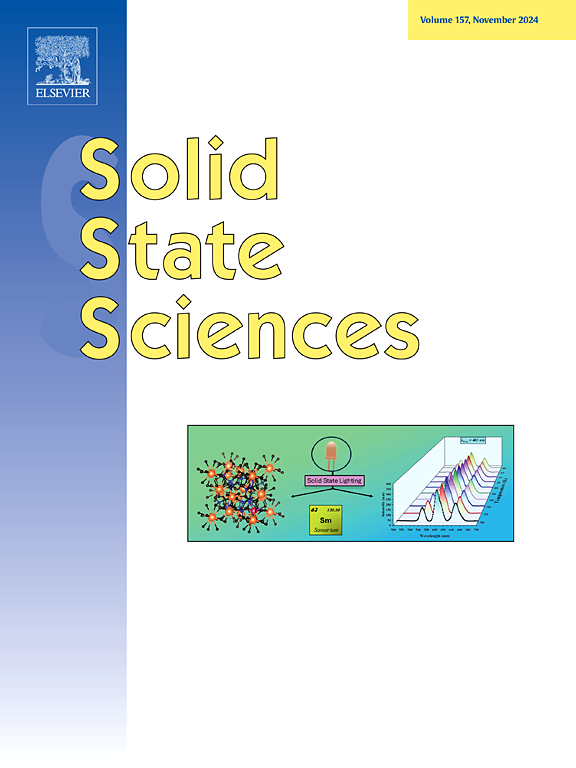M (M = Sn和Ti)取代b位对双钙钛矿结构Sr2(SmNb)1-0.5xMxO6陶瓷晶体结构和微波介电性能的影响
IF 3.3
3区 化学
Q2 CHEMISTRY, INORGANIC & NUCLEAR
引用次数: 0
摘要
在Sr2(SmNb)1-0.5xSnxO6 (SSNS)陶瓷中,Sn取代Sm和Nb在整个组成范围内形成固溶体。在Sr2(SmNb)1 ~ 0.5 xtixo6 (SSNT)陶瓷中,Ti取代Sm和Nb的溶解度极限为x = 0.5。利用Rietveld方法对SSNS和SSNT的晶体结构进行细化,发现当x≥0.5时,SSNS的晶体结构由单斜晶型(P21/n)转变为正交晶型(Pnma),而SSNT的晶体结构则在x = 0.5时由单斜晶型转变为三角晶型(R-3)。当x≥0.75时,SSNT陶瓷中检测到SrTiO3为次级相。SSNS和SSNT在M取代Sm和Nb后晶体结构对称性的变化也可以通过Raman峰的展宽得到,对应于对称BO6拉伸振动模式。M取代Sm和Nb导致SSNS和SSNT陶瓷的品质因子(Q·f)降低;陶瓷中b位有序度的降低和形态的改变影响了陶瓷单相区的Q·f值。SSNS陶瓷的Q·f值从35,732 GHz降至14,795 GHz,介电常数(εr)为31.1 ~ 14.7,谐振频率温度系数(TCf)为- 55.9 ~ - 65.7 ppm/°C。本文章由计算机程序翻译,如有差异,请以英文原文为准。

Influence of M (M = Sn and Ti) substitution for B-site on crystal structure and microwave dielectric properties of double perovskite-structured Sr2(SmNb)1-0.5xMxO6 ceramics
The Sn substitution for Sm and Nb in Sr2(SmNb)1-0.5xSnxO6 (SSNS) ceramics formed solid solutions over the whole composition range. The solubility limit of Ti substitution for Sm and Nb was x = 0.5 for Sr2(SmNb)1-0.5xTixO6 (SSNT) ceramics. Crystal structure refinement of SSNS and SSNT by the Rietveld method revealed that the crystal structure of SSNS changed from monoclinic (P21/n) to orthorhombic (Pnma) at x ≥ 0.5, while the crystal structure of SSNT changed from monoclinic to trigonal (R-3) at x = 0.5. At x ≥ 0.75, SrTiO3 was detected as a secondary phase in SSNT ceramics. Such changes in the symmetry of crystal structure for SSNS and SSNT by M substitution for Sm and Nb were also suggested by broadening of Raman peaks, which corresponds to the symmetric BO6 stretching vibration mode. The M substitution for Sm and Nb leads the decrease in the quality factor (Q・f) of SSNS and SSNT ceramics; the decrease in the degree of B-site ordering and morphological changes in these ceramics affects the Q・f values of the ceramics in single phase region. For SSNS ceramics, the Q・f values decreased from 35,732 GHz to 14,795 GHz, with a dielectric constant (εr) of 31.1–14.7 and the temperature coefficient of resonant frequency (TCf) of −55.9 to - 65.7 ppm/°C.
求助全文
通过发布文献求助,成功后即可免费获取论文全文。
去求助
来源期刊

Solid State Sciences
化学-无机化学与核化学
CiteScore
6.60
自引率
2.90%
发文量
214
审稿时长
27 days
期刊介绍:
Solid State Sciences is the journal for researchers from the broad solid state chemistry and physics community. It publishes key articles on all aspects of solid state synthesis, structure-property relationships, theory and functionalities, in relation with experiments.
Key topics for stand-alone papers and special issues:
-Novel ways of synthesis, inorganic functional materials, including porous and glassy materials, hybrid organic-inorganic compounds and nanomaterials
-Physical properties, emphasizing but not limited to the electrical, magnetical and optical features
-Materials related to information technology and energy and environmental sciences.
The journal publishes feature articles from experts in the field upon invitation.
Solid State Sciences - your gateway to energy-related materials.
 求助内容:
求助内容: 应助结果提醒方式:
应助结果提醒方式:


